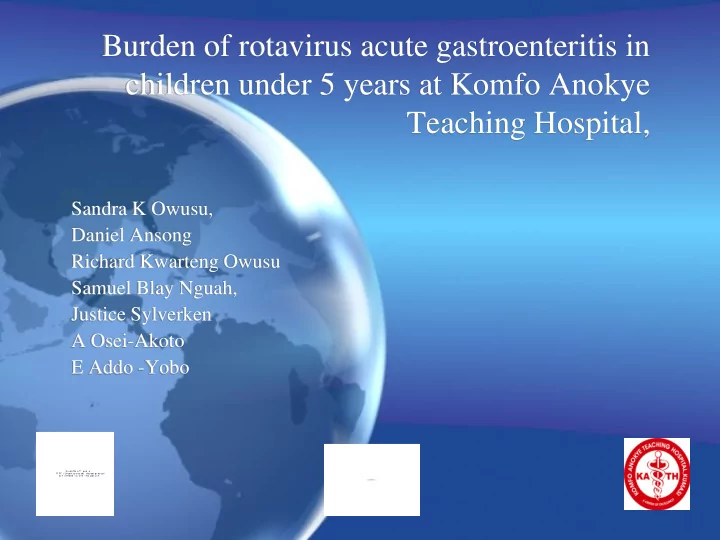

Burden of rotavirus acute gastroenteritis in children under 5 years at Komfo Anokye Teaching Hospital, Sandra K Owusu, Daniel Ansong Richard Kwarteng Owusu Samuel Blay Nguah, Justice Sylverken A Osei-Akoto E Addo -Yobo Q ui ck Ti m e™ an d a TI FF ( Un com pr ess ed) de com pr ess or ar e n eed ed t o see t h i s p i ct u r e. TI FF (U comp n Q ui ssed) d r e i me™ a ckT ecompresso a nd r are ne ed ed t o see t h i s pi ct u r e.
Introduction • Rotavirus is the most common cause of severe acute gastroenteritis in infants and young children worldwide. • It is estimated to account for 39% of all diarrhoeal deaths, this amounts to approximately half a million deaths each year among children aged under 5 years. • Greater than 80% of diarrhoeal deaths occurring in the developing countries. • Acute gastroenteritis caused by rotavirus is a frequent cause of admission and nosocomial infection in children who are hospitalized for reasons other than diarrhoea.
Design : • A prospective cross-sectional study was conducted in the Komfo Anokye Teaching Hospital between October 2007 and January 2008. • The study collected history of illness, stools and followed up all children reporting with diarrhoea defined as three or more episodes of loose watery stool within 24 hours period.
Inclusion and Exclusion criteria • Children under five years who presented with gastroenteritis lasting less than seven days -defined as an episode of at least three (3) loose or watery stools, or forceful vomiting in a 24-hr period in the 7 days before the medical visit. • Children less than five years whose parents and or guardians refused to consent to their participation were excluded. • Children with previous diagnosis of chronic disease of the (GIT) Gastrointestinal tract for which symptoms are compatible with the definition of acute gastroenteritis were also be excluded from the study.
• Methods: Sites • KATH, Department of Child Health, has 200 beds with bed occupancy rate between 80 to 120%. The monthly admission to the PEU averages 450 children • About 40% of these cases are children under five years. ;;;;;;
RESEARCH QUESTIONS 1. What are the socio-demographic characteristics of children with acute gastroenteritis? 2.What is the percentage of Rotavirus in children with acute gastroenteritis at Komfo Anokye Teaching hospital? 3.How do patients with Rotavirus gastroenteritis commonly present?
GENERAL OBJECTIVE To determine the prevalence of Rotavirus infection in children under five years with acute gastroenteritis at Komfo Anokye Teaching Hospital. SPECIFIC OBJECTIVES • To determine the socio-demographic characteristics of children with acute gastroenteritis at KATH • To determine the percentage of rotavirus acute gastroenteritis at KATH • To identify the common presentations of children with Rotavirus acute gastroenteritis
Demographic Characteristics of the Study subjects Characteristi Number(%) Positive Negative P-Value cs N(%) N(%) Sex Male 39(50.6) 21(53.9) 18(46.2) Female 38(49.4) 25(65.8) 13(34.2) Total 77(100) 46(59.7) 31(40.3) 0.29 Age 0-6mths 22(28.6) 15(68.2) 7(31.8) 7-12mths 31(40.3) 17(54.8) 14(45.2) 13-24mths 18(23.4) 12(66.7) 6(33.3) >24mths 6(7.8) 2(33.3) 4(66.7)
Social characteristics of the study subjects Education Number( Positive Negative P-Value %) N(%) N(%) No Formal 4(5.2) 3(75.0) 1(25.0) Primary 17(22.1) 10(58.8) 7(41.2) JSS 28(36.4) 16(57.1) 12(41.2) SSS 14(18.2) 8(57.1) 6(42.9) Tertiary 14(18.2) 9(64.3) 5(35.7) Total 77(100) 46(59.7) 31(40.3) 0.96
Occupation Occupation Number(%) Positive Negative P-Value N(%) N(%) Trader 27(35.1) 14(51.9) 13(48.1) Seamstress 2(2.6) 2(100) 0(0) Hairdresser 8(10.4) 7(87.5) 1(12.5) Teacher 22(29.9) 13(59.1) 9(40.9) Unemployed 8(23.0) 5(62.5) 3(37.5) Other 10(13.0) 5(50.0) 5(50.0) Total 77(100) 31(40.3) 46(59.7) 0.41
Source of drinking water Source Number( Positive Negative P-Value of water %) N(%) N(%) Pipe 54(70.1) 36(66.7) 18(33.3) Open 7(9.1) 3(42.9) 4(57.1) well Borehole 9(11.7) 4(44.4) 5(55.6) Stream 1(1.3) 0(0) 1(100) water Other 6(7.8) 3(50.0) 3(50.0) Total 77(100) 46(59.7) 31(40.3) 0.34
Results Figure 1: Results of stools samples tested for presence of rotavirus 43% Positive Negative 57%
Relationship between clinical features and presence of rotavirus infection Characteristics Number(%) Positive Negative P-Value N(%) N(%) Fever Yes 54(100) 33(61.1) 21(38.9) No 21(100) 11(52.4) 10(47.6) Total 75(100) 44(58.7) 31(41.3) 0.37 Dehydration None 22(100) 13(59.1) 9(40.9) Some 33(100) 19(57.6) 14(42.4) Severe 20(100) 12(60) 8(40.0) Total 75(100) 44(58.7) 31(41.3) 0.36 Vomiting Yes 14(100) 7(50.0) 7(50.0) No 61(100) 37(60.7) 24(39.3) Total 75(100) 44(58.7) 31(41.3) 0.54
Discussion • Prevalence of Rotavirus gastroenteritis • Common Presentations of children with Rotavirus Gastroenteritis • Demographic Characteristics and Rotavirus Prevalence • Maternal Educational Level and Occupation
• Conclusion • The study has demonstrated that rotavirus is an important cause of diarrhoea in the study area. • Younger children were the most affected group. The study did not show any relationship to other clinical symptoms.
CONCLUSION • 1. Rotavirus acute gastroenteritis is common in Komfo Anokye Teaching Hospital. • 2. Children less than 24 months are the age group most affected. • 3. Severe dehydration due to rotavirus acute gastroenteritis is common. • 4. Socioeconomic characteristic of care givers was not found to be a statistically significant factor.
Recommendation 1.A bigger study on a large scale considering the rural and urban distribution of the disease as well as the impact of the disease on the children will be helpful. This would enable us estimate the true burden of the disease in both settings. Such information would be used for policy formulation and planning towards disease prevention. 2.Since studies has shown that maternal socio-economic status does not impact on the prevalence of the disease. Efforts should be directed towards Maternal Education on the home management of diarrohea across all levels of socioeconomic class. 3.The high prevalence of rotavirus acute gastroenteritis at this tertiary care center may indicate the need to consider rotavirus vaccination as part of our Expanded Programme on Immunization.
Recommendation • Study to evaluate the association between presence of antigenemia and severity of rotavirus diarrhoea.
Acknowledgements • Department of Child Health-KATH • Malaria Research Lab-KATH • Nogouchi Memorial Institute-Legon
Recommend
More recommend